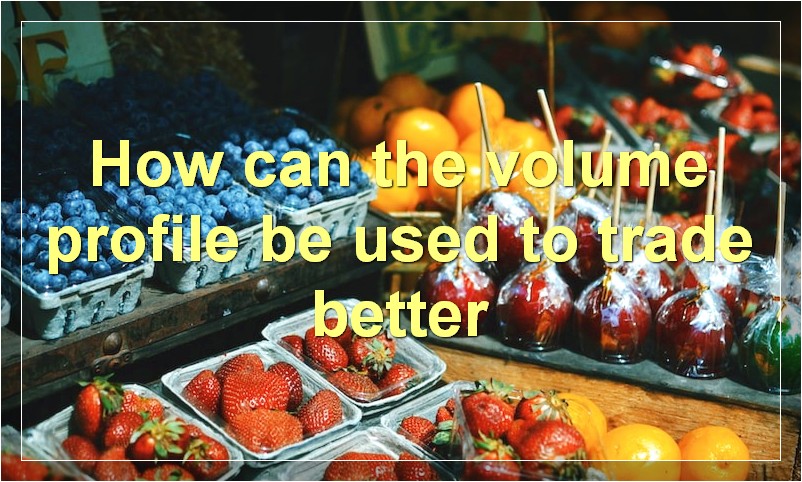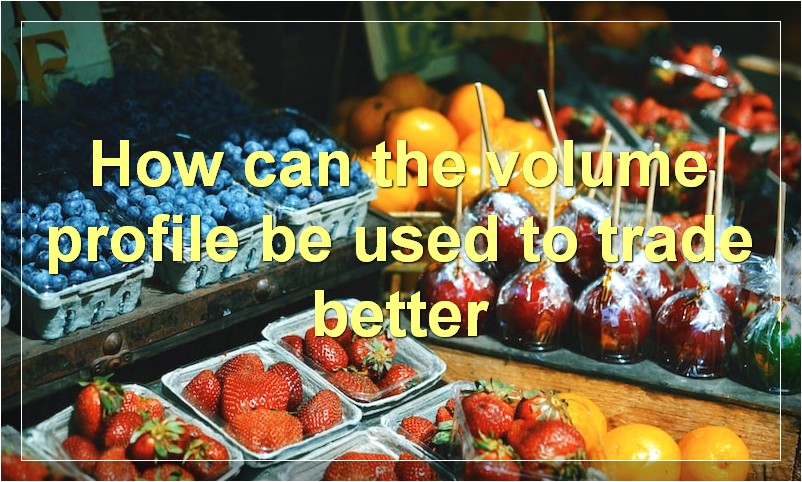If you’re looking to take your trading to the next level, then you need to start using volume profile. In this ultimate guide, we’ll show you everything you need to know about volume profile, including how to use it and interpret the data.
What is the volume profile on Trading View
The volume profile is a graphical representation of how much trading activity has occurred at different prices for a security or financial instrument. The profile is created by plotting the quantity of shares or contracts traded at each price level.
The volume profile can be used by traders to find potential areas of support and resistance, as well as to identify potential trade opportunities. The profile can also be used to assess the strength of a trend.
When looking at the volume profile, traders will often look for areas where there is a large amount of trading activity. These areas may be potential support or resistance levels. Traders may also look for areas where there is a lack of trading activity. These areas may be potential trading opportunities.
The volume profile can be a helpful tool for traders when making decisions about where to enter and exit trades. It can also be helpful in assessing the strength of trends.
How can the volume profile be used to trade better

The volume profile is a tool that can be used to trade better by providing information about the trading activity in a given market. It can show where the most active trading is taking place, as well as the average price at which trades are being made. This information can be used to make better informed decisions about when to enter and exit trades.
What do the different colors on the volume profile represent
The volume profile is a graphical representation of the amount of trading activity for a given security. The profile is typically shown as a histogram, with the x-axis representing the price of the security and the y-axis representing the volume of trading activity.
There are a few different ways that the volume profile can be represented, but the most common is by using different colors to represent different ranges of volume. For example, one common color scheme is to use green to represent low volume, yellow to represent moderate volume, and red to represent high volume.
This color-coding can be helpful in identifying areas of support and resistance, as well as potential trading opportunities. For example, if there is a large spike in volume followed by a sharp price move, that could be an indication of a breakout. Alternatively, if there is a sudden increase in volume but the price doesn’t move much, that could be an indication of a potential reversal.
How is the volume profile different from a traditional candlestick chart
A traditional candlestick chart shows the open, high, low, and close price for a given period of time. The volume profile is a histogram that shows how much volume traded at each price level.
What are some of the benefits of using a volume profile
A volume profile is a tool that displays the amount of trading activity for a given security at specific price levels. The profile is created by aggregating the volume traded at each price level and then plotting it on a graph. The resulting profile can provide valuable information about the supply and demand dynamics in the market for a particular security.
Some of the benefits of using a volume profile include:
1. Gain insights into market liquidity
The volume profile can give traders an idea of how much liquidity is available at different price levels. This information can be helpful when making decisions about where to enter and exit trades.
2. See where prices are most likely to move
By identifying areas of high volume, traders can get a sense of where prices are most likely to move. This information can be used to make trade entries and exits more precise.
3. Get an idea of investor sentiment
The volume profile can also provide insight into investor sentiment. For example, if there is heavy buying activity at a certain price level, it may be an indication that investors are bullish on the security.
How can I use the volume profile to identify trading opportunities

The volume profile is a versatile tool that can be used to identify trading opportunities in the market. Here are a few ways to use the volume profile to your advantage:
1. Look for areas of high volume to identify potential support and resistance levels.
2. Use the volume profile to confirm trends. If the volume profile is rising along with prices, it is a sign that the current trend is strong and likely to continue.
3. Look for reversals in the volume profile. If the volume profile starts to decline while prices are still rising, it is a sign that the current trend may be about to reverse.
4. Use the volume profile to monitor buy and sell pressure in the market. If there is more buying pressure than selling pressure, prices are likely to rise. Conversely, if there is more selling pressure than buying pressure, prices are likely to fall.
5. Use the volume profile to help time your entries and exits. If you see a sharp spike in volume followed by a quick decline, it could be a sign that prices are about to move in the opposite direction. This can be used as a timing signal to enter or exit a trade.
What is the difference between a bullish and bearish market
There are two different types of markets- the bullish market and the bearish market. The main difference between the two is that in a bullish market, prices are rising and in a bearish market, prices are falling.
A bullish market is when investors are confident about the future and believe that prices will continue to rise. This usually happens when the economy is doing well and there is high demand for stocks and other investments. A bearish market is the opposite- investors are pessimistic about the future and believe that prices will continue to fall. This can happen when the economy is struggling or there is political unrest.
Both bullish and bearish markets can present opportunities for investors. In a bullish market, you can buy stocks at lower prices and then sell them when prices go up. In a bearish market, you can short selling stocks- this is where you sell a stock you don’t own and then buy it back at a lower price.
It’s important to keep an eye on both bullish and bearish markets so that you can make informed investment decisions.
What does it mean when the market is said to be “overbought” or “oversold”
When the market is said to be “overbought” or “oversold”, it means that prices have risen or fallen to a level that is considered too high or too low in relation to recent prices. This can be caused by a number of factors, including investor sentiment, economic conditions, and company news. Overbought and oversold conditions are often used by traders to indicate when a stock is due for a correction.
How can I use the volume profile to determine where to place my stop loss orders
The volume profile is a tool that can be used to help determine where to place stop loss orders. By looking at the volume profile, traders can get an idea of where the most trading activity is taking place and where there is less activity. This can be helpful in determining where to place stop loss orders so that they are not triggered by normal market activity.
Is there anything else I should know about using the volume profile in my trading
The volume profile is a tool that allows traders to see the amount of trading activity that has occurred at a certain price level. This information can be used to make trading decisions based on market liquidity.

